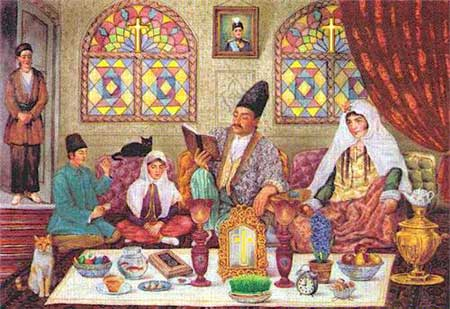Nowrūz (Persian: نوروز, IPA: [nouˈɾuːz], "New Day", originally "New Light") is the name of the New Year by Solar calendar and the corresponding traditional celebrations. Nowruz is also widely referred to as the Persian New Year.
Nowruz is celebrated and observed by Iranian peoples and the related cultural continent and has spread in many other parts of the world, including parts of Central Asia, South Asia, Northwestern China, the Crimea and some groups in the Balkans.
Nowruz marks the first day of spring and the beginning of the year in Iranian calendar. It is celebrated on the day of the astronomical vernal equinox, which usually occurs on March 21 or the previous/following day depending on where it is observed. As well as being a Zoroastrian holiday and having significance amongst the Zoroastrian ancestors of modern Iranians, the same time is celebrated in parts of the South Asian sub-continent as the new year. The moment the Sun crosses the celestial equator and equalizes night and day is calculated exactly every year and Iranian families gather together to observe the rituals.
Originally being a Zoroastrian festival, and the holiest of them all, Nowruz is believed to have been invented by Zoroaster himself, although there is no clear date of origin. Since the Achaemenid era the official year has begun with the New Day when the Sun leaves the zodiac of Pisces and enters the zodiacal sign of Aries, signifying the Spring Equinox.
The Jewish festival of Purim is probably adopted from the Persian New Year. It is also a holy day for Sufis, Ismailis, Alawites, Alevis, and adherents of the Bahá'í Faith.
The term Nowruz in writing, first appeared in Persian records in the 2nd century AD, but it was also an important day during the time of the Achaemenids (c. 648-330 BC), where kings from different nations under the Persian empire used to bring gifts to the Emperor, also called King of Kings (Shahanshah), of Persia on Nowruz. The significance of Nowruz in the Achaemenid empire was such that the great Persian king Cambyses II's appointing as the king of Babylon was legitimized only after his participation in the New Year festival (Nowruz).
The UN's General Assembly in 2010 recognized the International Day of Nowruz, describing it a spring festival of Persian origin which has been celebrated for over 3,000 years.[12][13] During the meeting of The Inter-governmental Committee for the Safeguarding of the Intangible Heritage of the United Nations, held between 28 September – 2 October 2009 in Abu Dhabi, Nowrūz was officially registered on the UNESCO List of the Intangible Cultural Heritage of Humanity
EtymologyThe term Nowruz is a Persian compound-word and consists of:
now (Old Persian nava) means "new" and has the following cognates, in English new, in Latin novus, German neu, Sanskrit nava, etc. The Persian pronunciation differs in the many dialects of the language: while the eastern dialects have preserved the original diphthong (IPA: [næuˈɾoːz]), the western dialects usually pronounce it with a different diphthong (IPA: [nouˈɾuːz]), and some colloquial variants (such as the Tehrani accent) pronounce it with a monophtong (IPA: [noˈɾuːz]).
rōz (also with various pronuciations, such as rūz, rozh, or roj) means "day" in Middle- and Modern Persian, as well as related languages, such as Kurdish. The original meaning of the word, however, was "light". The term is derived from Avestan *rowch-, itself derived from Proto-Indo-European *leuk- (l <-> r and k <-> ch sound changes are common in Indo-European languages), and is related to Sanskrit ruci, Latin lux and, in fact, English light.
now (Old Persian nava) means "new" and has the following cognates, in English new, in Latin novus, German neu, Sanskrit nava, etc. The Persian pronunciation differs in the many dialects of the language: while the eastern dialects have preserved the original diphthong (IPA: [næuˈɾoːz]), the western dialects usually pronounce it with a different diphthong (IPA: [nouˈɾuːz]), and some colloquial variants (such as the Tehrani accent) pronounce it with a monophtong (IPA: [noˈɾuːz]).
rōz (also with various pronuciations, such as rūz, rozh, or roj) means "day" in Middle- and Modern Persian, as well as related languages, such as Kurdish. The original meaning of the word, however, was "light". The term is derived from Avestan *rowch-, itself derived from Proto-Indo-European *leuk- (l <-> r and k <-> ch sound changes are common in Indo-European languages), and is related to Sanskrit ruci, Latin lux and, in fact, English light.
Nowruz and the spring equinox
The first day on the Iranian calendar falls on the March equinox, the first day of spring. At the time of the equinox, the sun is observed to be directly over the equator, and the north and south poles of the Earth lie along the solar terminator; sunlight is evenly divided between the north and south hemispheres.
In ca. 11 century CE major reforms of Iranian calendars took place and whose principal purpose was to fix the beginning of the calendar year, i.e. Nowrūz, at the vernal equinox. Accordingly, the definition of Nowruz given by the Iranian scientist Ṭūsī was the following: "the first day of the official new year [Nowruz] was always the day on which the sun entered Aries before noon".
In ca. 11 century CE major reforms of Iranian calendars took place and whose principal purpose was to fix the beginning of the calendar year, i.e. Nowrūz, at the vernal equinox. Accordingly, the definition of Nowruz given by the Iranian scientist Ṭūsī was the following: "the first day of the official new year [Nowruz] was always the day on which the sun entered Aries before noon".



No comments:
Post a Comment